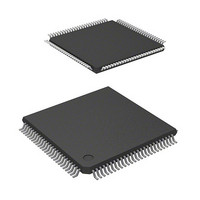DF2148BTE20 Renesas Electronics America, DF2148BTE20 Datasheet - Page 527

DF2148BTE20
Manufacturer Part Number
DF2148BTE20
Description
IC H8S MCU FLASH 128K 100-QFP
Manufacturer
Renesas Electronics America
Series
H8® H8S/2100r
Specifications of DF2148BTE20
Core Processor
H8S/2000
Core Size
16-Bit
Speed
20MHz
Connectivity
I²C, IrDA, SCI, X-Bus
Peripherals
PWM, WDT
Number Of I /o
74
Program Memory Size
128KB (128K x 8)
Program Memory Type
FLASH
Ram Size
4K x 8
Voltage - Supply (vcc/vdd)
4.5 V ~ 5.5 V
Data Converters
A/D 8x10b; D/A 2x8b
Oscillator Type
Internal
Operating Temperature
-20°C ~ 75°C
Package / Case
100-TQFP, 100-VQFP
Lead Free Status / RoHS Status
Contains lead / RoHS non-compliant
Eeprom Size
-
Other names
HD64F2148BTE20
HD64F2148BTE20
HD64F2148BTE20
Available stocks
Company
Part Number
Manufacturer
Quantity
Price
Company:
Part Number:
DF2148BTE20V
Manufacturer:
Renesas Electronics America
Quantity:
10 000
- Current page: 527 of 847
- Download datasheet (5Mb)
2
Section 16 I
C Bus Interface (IIC) (Optional)
2
Settings of bits other than TRS in ICCR that allow I
C bus format operation
2
Automatic switching is performed from formatless mode to the I
C bus format when the SW bit in
DDCSWR is automatically cleared to 0 on detection of a falling edge on the SCL pin. Switching
2
from the I
C bus format to formatless mode is achieved by setting the SW bit in DDCSWR to 1 by
software.
2
In formatless mode, bits (such as MSL and TRS) that control the I
C bus interface operating mode
2
must not be modified. When switching from the I
C bus format to formatless mode, set the TRS
bit to 1 or clear it to 0 according to the transfer direction (transmission or reception) in formatless
2
mode, then set the SW bit to 1. After automatic switching from formatless mode to the I
C bus
format (slave mode), the TRS bit is automatically cleared to 0 in order to wait for slave address
reception.
2
If a falling edge is detected on the SCL pin during formatless operation, the mode of the I
C bus
2
interface is immediately switched to I
C bus format before a stop condition is detected.
16.4.9
Operation Using DTC
This LSI provides the DTC to allow continuous data transfer. The DTC is initiated when the IRTR
flag is set to 1, which is one of the two interrupt flags (IRTR and IRIC). When the ACKE bit is 0,
the ICDRE, IRIC, and IRTR flags are set at the end of data transmission regardless of the
acknowledge bit value. If the ACKE bit is 1, the ICDRE, IRIC, and IRTR flags are set when data
transmission is completed with the acknowledge bit value of 0, and if the ACKE bit is 1, only the
IRIC flag is set when data transmission is completed with the acknowledge bit value of 1.
When initiated, the DTC transfers specified number of bytes, clears the ICDRE, IRIC, and IRTR
flags to 0. Therefore, no interrupt is generated during continuous data transfer; however, if data
transmission is completed with the acknowledge bit value of 1 when the ACKE bit is 1, the DTC
is not initiated, thus allowing an interrupt to be generated if enabled.
The acknowledge bit may indicate specific events such as completion of receive data processing
for some receiving devices, and for other receiving devices, the acknowledge bit may be fixed at
1, indicating no specific events.
2
The I
C bus format provides for selection of the slave device and transfer direction by means of
the slave address and the R/W bit, confirmation of reception with the acknowledge bit, indication
of the last frame, and so on. Therefore, continuous data transfer using the DTC must be carried out
in conjunction with CPU processing by means of interrupts.
Table 16.7 shows some examples of processing using the DTC. These examples assume that the
number of transfer data bytes is known in slave mode.
Rev. 3.00 Mar 21, 2006 page 471 of 788
REJ09B0300-0300
Related parts for DF2148BTE20
Image
Part Number
Description
Manufacturer
Datasheet
Request
R

Part Number:
Description:
0.6mm Pitch Board-to-Fine-Coaxial Cable Connectors
Manufacturer:
Hirose Electric
Datasheet:

Part Number:
Description:
0.6mm Pitch Board-to-fine-coaxial Cable Connectors
Manufacturer:
Hirose Electric
Datasheet:

Part Number:
Description:
0.6mm Pitch Board-to-fine-coaxial Cable Connectors
Manufacturer:
Hirose Electric
Datasheet:

Part Number:
Description:
Right angle, Two-piece for fine coaxial cable, Discrete wire connectors; HRS No: 687-0001-5 56; No. of Positions: 20; Connector Type: Board mounting; Contact Gender: Female; Contact Spacing (mm): 0.6; Terminal Pitch (mm): 0.6; PCB Mount Type: SMT; Cu
Manufacturer:
Hirose Electric

Part Number:
Description:
0.6mm Pitch Board-to-fine-coaxial Cable Connectors
Manufacturer:
Hirose Electric
Datasheet:

Part Number:
Description:
0.6mm Pitch Board-to-Fine-Coaxial Cable Connectors
Manufacturer:
HIROSE [Hirose Electric]
Datasheet:

Part Number:
Description:
KIT STARTER FOR M16C/29
Manufacturer:
Renesas Electronics America
Datasheet:

Part Number:
Description:
KIT STARTER FOR R8C/2D
Manufacturer:
Renesas Electronics America
Datasheet:

Part Number:
Description:
R0K33062P STARTER KIT
Manufacturer:
Renesas Electronics America
Datasheet:

Part Number:
Description:
KIT STARTER FOR R8C/23 E8A
Manufacturer:
Renesas Electronics America
Datasheet:

Part Number:
Description:
KIT STARTER FOR R8C/25
Manufacturer:
Renesas Electronics America
Datasheet:

Part Number:
Description:
KIT STARTER H8S2456 SHARPE DSPLY
Manufacturer:
Renesas Electronics America
Datasheet:

Part Number:
Description:
KIT STARTER FOR R8C38C
Manufacturer:
Renesas Electronics America
Datasheet:

Part Number:
Description:
KIT STARTER FOR R8C35C
Manufacturer:
Renesas Electronics America
Datasheet:

Part Number:
Description:
KIT STARTER FOR R8CL3AC+LCD APPS
Manufacturer:
Renesas Electronics America
Datasheet:











